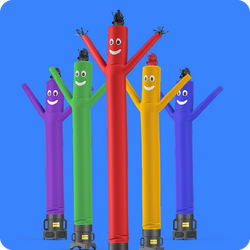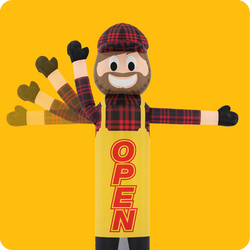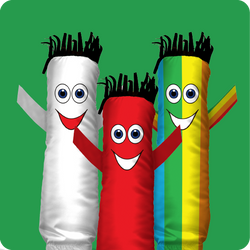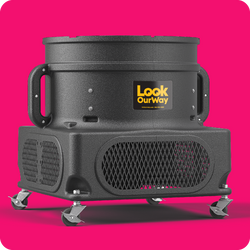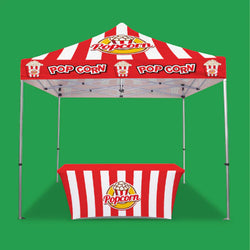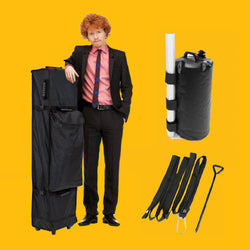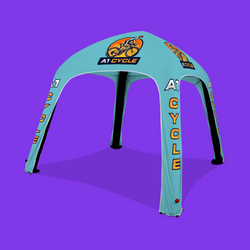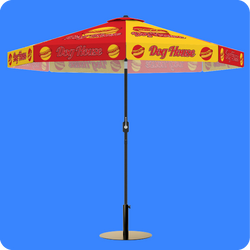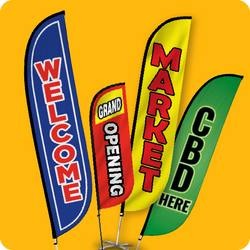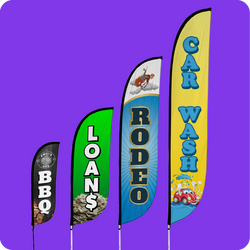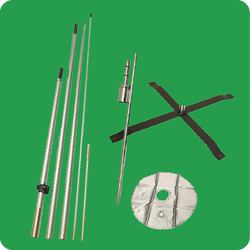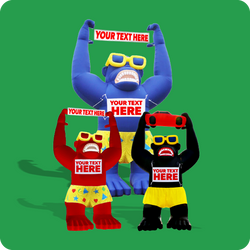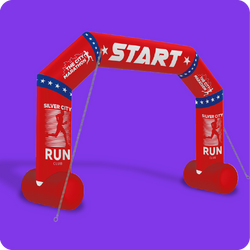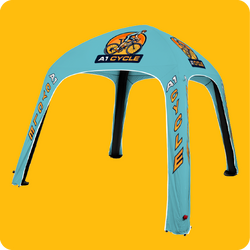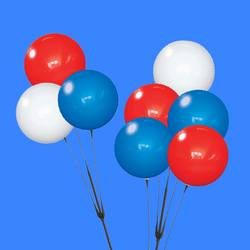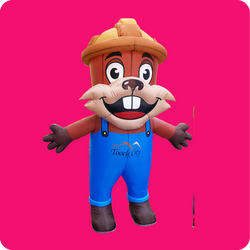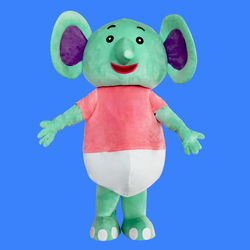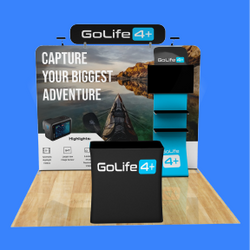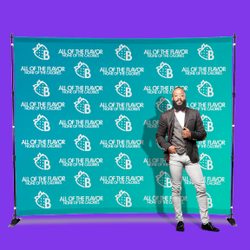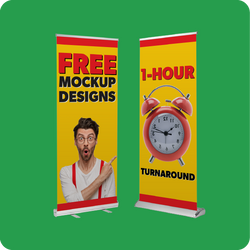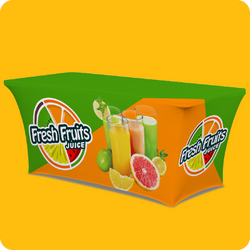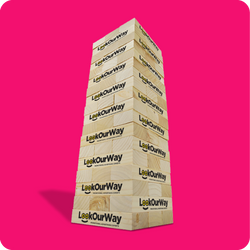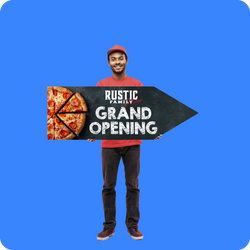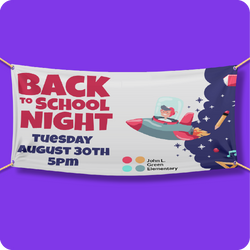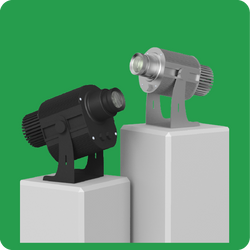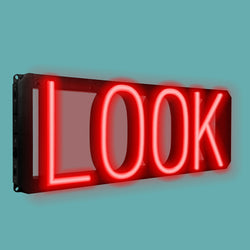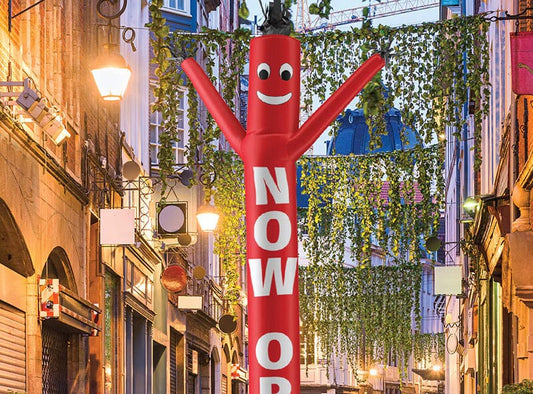Event Marketing Tactics That Boost Brand Awareness
Event Marketing Tactics That Boost Brand Awareness
Image Source: Freepik
You have a great product, a smart team, and big ideas. But there's one problem: your potential customers don't know who you are yet.
Event marketing can change that.
Maybe you've tried digital marketing or social media posts. Those work well, but sometimes, they're not enough. Face-to-face connections still matter. Trade shows, conferences, and local events get your brand in front of real people. They help you meet your business goals, such as new customers, loyal customers, and more sales.
In this guide, you'll learn powerful marketing tactics. You'll discover how to use trade show booth displays and custom table covers to grab attention. You'll see how to use banner stands and backdrop displays to tell your brand's story clearly. You'll also find tips on virtual events, webinars, and simple ways to make your event memorable.
What Is Event Marketing?
Event marketing uses live or digital experiences to connect with your target audience and reach clear marketing goals. It blends brand awareness, content creation, and real-time engagement into one strategy.
Examples like Red Bull's Flugtag and Salesforce's Dreamforce show how events can boost social media, email lists, and even SEO. Whether in-person or online, smart events lead to better conversions and stronger messaging if you're a global brand or a small business.
Benefits of Event Marketing
Event marketing works because it puts you in front of real people. The results go beyond the buzz. You get clear, measurable returns if you consider the right things. Here's what you gain when you do it well.
1. Grow Your Target Audience
Events help you find people who want what you offer. These aren't random clicks or empty impressions. These are handshakes, eye contact, and real interest. If you're a small business or scaling fast, face-to-face interactions help filter the noise.
You meet your audience in real-time. You see what makes them pause. You hear their questions. You find patterns in their pain points. That insight shapes your future content creation and messaging. It sharpens your focus and removes the guesswork from your marketing plan.
Each event gives you the chance to update your personas with fresh data. You'll understand the demographics that matter most. And that makes your next campaign more precise and less expensive.
2. Build a Stronger Email List
An email list is still one of your best digital tools. But the list only works if it's full of the right people. Events help you gather contacts from people who already showed interest. That changes the way they respond to your email marketing later.
Visitors signed up at your booth or scanned your QR code. These leads convert better, click more, and stay longer, so you get stronger open rates, higher click-through rates, and better retention.
Use this list to run targeted email campaigns. Pair it with marketing automation to save time and keep your messaging consistent. Smart marketers use every name wisely. Don't waste the chance to follow up with relevance.
3. Collect Real-Time Insights and Data
Event marketing gives you feedback quickly. In-person conversations uncover new questions, unmet needs, and trends. People will tell you what they like, what confuses them, and what they compare you to.
Capture this data. It's more useful than a spreadsheet of analytics from a social media post. It helps you build better content, plan smarter webinars, and refine your landing page copy. You'll also get a clearer picture of your target market, including psychographics and behavior
4. Track Real Metrics That Guide Your Strategy
Events give you numbers you can use. You can track leads collected, conversations made, and audience size. You can measure the ROI of your booth setup, giveaways, and sponsorships.
When you run a PPC campaign tied to the event or use Google Ads to boost a product demo, you can return those clicks to real-world outcomes. Your marketing team can spot what worked and what flopped. Then, they can use that knowledge to plan the next event better.
Tools like HubSpot help automate this process. They track the data you collect and link it back to specific campaigns. That makes your marketing goals easier to reach because you're working with facts.
Use this information to inform your SEO strategy, update your value proposition, and create more relevant content across all your marketing channels.
5. Strengthen Relationships and Build Trust
At events, you're talking to a real person. People trust what they can see, hear, and touch. When they meet you, they remember you. They trust your brand more when your booth looks sharp, and your message is clear.
That trust leads to loyal customers. It opens doors for partnerships, influencer marketing, and user-generated content. It makes it easier to earn referrals and build communities around your product.
Even a single conversation can lead to long-term value. When people connect with your brand identity in person, they're more likely to engage online, even through social media, email lists, or future campaigns.
6. Boost Your Brand Visibility in a Saturated Market
Your brand has seconds to make an impression online. But you have space and room to stand out and be seen at an event.
A bold booth, sharp messaging, and thoughtful design put your brand where it can't be ignored. You won't be fighting algorithms or ad fatigue. You're in the real world, where attention lasts longer than a swipe.
Events let you showcase your brand identity visually, verbally, and through action. From your banner stands to your conversations, everything tells a story. And that story sticks.
This kind of visibility is positioning. It tells your target market who you are, what you do, and why it matters.
7. Test New Marketing Ideas in the Field
Events let you experiment. You can try a new offer, test your latest messaging, or see how people react to a rebrand, all in real-time.
Does your new value proposition land? Does that incentive get signups? You find out fast. You make changes on the spot. You refine your marketing plan while you're still on the floor.
This kind of testing helps small businesses and large teams alike. It gives your marketing team the confidence to roll out smarter strategies based on what worked in the field.
Face-to-face testing shortens the feedback loop. It gives you clarity, making every future campaign stronger.
Different Types of Event Marketing
You can reach your target audience in many ways. Different event formats fit different business goals. Here are several types of event marketing you can use.
Trade Shows
Trade shows put you in front of real people. You get to see reactions instantly and hear feedback in person. The best brands listen more than they talk. You see facial expressions and body language. These clues matter.
Your booth is a stage for storytelling. Use simple, powerful visuals to tell your story. Give visitors clear, easy-to-follow demonstrations. Let people try your products themselves. People remember experiences more clearly than pitches.
Face-to-face meetings help build trust faster. Trust moves potential customers closer to buying decisions. It helps you gather better leads, which makes your marketing strategy smarter. The conversations at trade shows offer insights you won't find online. Use those insights to sharpen your personas and messaging.
Trade shows also allow quick adjustments. If something isn't working, you pivot immediately. Move displays or change your approach. You adapt on the spot. Flexibility gives you an advantage over brands that can't shift quickly.
Finally, don't forget networking. In addition to meeting customers at tradeshows, you meet potential partners, suppliers, and influencers. These connections open doors you might never have found online.
Virtual & Hybrid Events
Virtual events erase borders. Geography doesn't matter anymore. You can reach people across town or across the world. Your target market expands instantly. A bigger audience means more data and deeper insights. Use these insights to improve your future marketing efforts.
Hybrid events blend the best of both worlds. They allow people to attend in person or log in from home. This flexibility attracts different demographics. Busy entrepreneurs or remote teams can join easily. It's inclusive, smart marketing.
Virtual events also give you detailed metrics. You track attendance, engagement, and conversation rates in real time. You know exactly when people drop off or lean in.
Technology like polls, live chats, and Q&A sessions make virtual events interactive. Engagement happens naturally. These digital tools help your audience feel connected. Connection turns into trust, and trust boosts conversations.
After events, repurpose your content. Create podcasts, videos, or short clips for social media. Every virtual event gives you content that keeps working, and your event keeps driving results long afterward.
Educational Workshops & Seminars
People crave knowledge. They want answers to their problems. Workshops and seminars let you solve problems directly. Provide useful, clear information and address pain points openly. Your audience sees you as helpful rather than sales-driven.
Educational sessions position your brand as an authority, building trust quickly. Trust shortens the path to purchase. People buy from brands they trust. By sharing what you know, you prove your value without pushing.
Workshops create a sense of community. People who learn together feel connected, and that connection often leads to loyalty. Loyal customers stick around and recommend you to others. Referrals come naturally when people see genuine value.
Image Source: Freepik
Use workshops to test ideas, too. You'll see which topics attract attention. Find out what your audience truly cares about. This will shape your future marketing campaigns and inform your messaging across all channels.
Educational content is perfect for lead generation. People willingly share their email to learn something valuable. Email marketing from these leads has high conversion rates. People pay attention to messages they've chosen to receive.
Keep your educational sessions interactive. Answer questions clearly and directly. Encourage discussion and participation. An active audience learns better and remembers you longer.
Product Launches
A product launch is when your brand says, "Here's something new!" But attention is earned, not given. To earn it, your marketing strategy must be sharp.
Start by knowing your target market. What keeps them up at night? What problem does your new product solve? Build your messaging around those pain points. Be clear, be brief, and speak directly. Let your value proposition shine without fluff.
Visuals matter here. Use custom flags, banners, or bold backdrop displays to draw eyes at live events. Set up a branded booth that sparks curiosity. Use infographics to show how your product works. These simple tools turn a space into a branded experience.
Pair your in-person efforts with digital marketing. Social media marketing can help create buzz. Influencers, user-generated content, and short, engaging posts on platforms like TikTok and LinkedIn can push your product into new conversations.
Don't stop at the launch. Use real-time videos, email updates, and follow-up webinars to keep the story going. Keep your messaging consistent across all marketing channels, online and offline.
Track your metrics. Watch click-through rates, conversions, and audience engagement. Product launches move fast, but smart marketers keep learning. A well-executed launch builds momentum and turns attention into loyal customers.
Image Source: Freepik
Nonprofit & Fundraising Events
People give when they feel something. Nonprofit events work best when they create that feeling. They connect a cause to a face, a story, a real-world need. Your job is to make that need clear.
At fundraising events, your goal is to tell a clear story. Visual tools like branded table covers, flags, or pop-up banners to set the scene. These tools help carry your message and create a space that feels united, thoughtful, and mission-focused.
Photo backdrops also play a key role. They turn moments into stories, stories your audience will want to share on social media. That means more user-generated content, more reach, and better brand awareness for your cause.
Incentives help too. Offer branded items or interactive experiences that align with your mission. Set up a referral system or use QR codes that lead to a landing page with your donation form. Track results with your marketing automation tool and refine your email marketing accordingly.
Events like these give your marketing team the chance to gather real-time data. Who showed up? What messaging worked? What drove conversations? Use those insights to guide your next marketing plan.
Nonprofit marketing builds trust, creates shared values, and gives your audience the tools to act. With the right setup, both physical and digital, you turn interest into action. And action into lasting impact.
Top Event Marketing Tactics
You can boost your brand awareness with smart, clear marketing tactics. Some tactics use visuals. Others rely on digital tools or strategic planning.
Product displays help your brand stand out at trade shows and events. Banner stands to grab attention quickly. Booth displays invite potential customers into your space. Backdrop displays tell your brand's story clearly.
Digital tactics expand your reach. Social media posts and influencer marketing build buzz. Pay-per-click (PPC) campaigns and Google Ads drive traffic to your landing page. SEO-friendly content creation helps your ranking on search engines.
Strategic tactics focus on your marketing plan and messaging. Market research helps you know your target audience. Email marketing builds relationships. Lead generation tools and marketing automation track metrics, click-through rates, and conversions.
Here are a few top event marketing tactics to explore:
Trade Show Booth Displays
An example trade show booth display (Image source: Look Our Way)
Your booth display makes a first impression. Good impressions bring new customers.
Use interactive technology. Tablets and touchscreen displays let your target audience explore your products themselves. Augmented reality can show your new product in action. Real-time demos grab attention and drive conversations.
Your booth design matters. Keep your messaging clear and focused on your value proposition. High-quality infographics highlight key points and pain points. Use pop-up displays or digital screens to share user-generated content or testimonials.
Consider spatial design. Your booth needs space to move freely. Give visitors clear paths and comfortable spaces. Open areas encourage interaction and longer visits. That means higher lead generation and better retention.
Finally, make your booth shareable. Offer incentives to visitors who post on social media platforms like LinkedIn or TikTok. Influencer marketing partnerships can extend your reach.
Banner Stands
Banner stands can quickly guide your audience's eyes. They show your message clearly. Good placement is key.
Put banner stands where people naturally gather. Think entrances, busy walkways, or areas near popular events. The right spot increases visibility and draws potential customers toward your booth.
Mobility matters. Banner stands are easy to move. You can test different placements in real-time. If foot traffic shifts, you shift, too. That's an agile marketing strategy at work.
Visual storytelling is powerful. Use simple, clear graphics and messaging. Your target audience should grasp your value proposition immediately. High-quality infographics, clear headlines, and clean design encourage visitors to stop and learn more.
Banner stands can also direct people online. Include QR codes that lead to your landing page or social media platforms like LinkedIn or TikTok. This boosts conversions and lead generation even after the event ends.
Backdrop Displays
Backdrop displays make your brand easy to remember. They create visual impact and give your target audience a reason to engage.
Customization helps build your brand identity. Use colors, logos, and messaging that match your overall marketing plan. Keep designs simple but bold. Visitors quickly understand who you are and what you offer.
Backdrops also encourage visitors to share their experiences. A well-designed backdrop becomes a spot for photos and selfies. People love posting these images on social media platforms. User-generated content spreads your brand awareness even further.
You can also use multimedia to make your backdrop more engaging. Digital screens can play product videos, influencer testimonials, or customer stories. Multimedia integration helps your booth stand out. It turns passive viewing into active participation.
Great backdrops strengthen marketing efforts. They create opportunities for referrals, improve lead generation, and boost conversions.
Custom Table Covers
Custom table covers show professionalism. They make your brand identity consistent at any event. A consistent brand builds trust with your target audience.
Choose simple designs. Use your logo, clear messaging, and brand colors. Visitors notice quality right away. This makes potential customers confident in your value proposition.
Think about durability. Events put stress on table covers. Choose high-quality materials that resist wrinkles and stains. Easy-to-clean fabrics keep your covers looking sharp event after event.
Transportation matters, too. Lightweight, foldable covers simplify travel. Your marketing team will appreciate covers that pack small and travel easily.
Good custom table covers support your marketing strategy. They help you meet your business objectives by improving first impressions. Little details matter in effective marketing.
Best Practices for a Standout Booth Experience
A standout booth keeps visitors engaged. These tactics help you capture attention and turn visits into real marketing results.
1. Create Interactive Experiences |
Don't just show, let people do. Interactive booths turn visitors into participants. Let them touch, click, and explore. A product that can be tested becomes real. A screen that responds becomes a story. Give your audience a reason to stay. Set up screens with simple choices. Ask a quick question. Offer a quick demo. Use real-time polls or feedback stations to spark engagement. Interaction fuels conversations. It opens the door to meaningful conversations and that's where trust begins. |
2. Use Gamification to Engage Visitors |
People don't forget how you made them feel. Games create emotion: fun, surprise, and even a little friendly competition. That emotional spike makes your booth memorable. You don't need to build an app. A simple spin-to-win, trivia quiz, or scavenger hunt can do the job. Tie the game to your value proposition. Make every prize or outcome reinforce your brand identity. Track the results. How many people played? Who followed up later? Use that data in your marketing strategy. Gamification is fun and a smart lead-generation tool. |
3. Smart Lead Capture Strategies |
Leads matter. But the way you collect them matters more. Don't hand out flyers and hope. Use digital tools that make signups easy and fast. Set up tablets at key spots. Use a QR code that links to a focused landing page. Keep forms simple: name, email, and one question that helps you sort personas later. Use that info right away. Let marketing automation tools handle the follow-up. Send an email within hours. Thank them. Share something useful. This kind of speed shows you're listening, and that earns attention. |
4. Train Your Staff Effectively |
Your booth can be flawless, but if your team fumbles the message, you lose momentum. People don't remember banners. They remember conversations. Train your staff on facts. Train them to listen. Help them spot pain points fast. Give them a script, then let them make it their own. A confident team brings your messaging to life. Focus on clarity without jargon or fluff. Help your team share your value proposition in one line. Then, back it up with simple proof. Good conversations create real leads and, often, loyal customers. |
5. Design for Flow and Comfort |
People won't stay in a crowded, chaotic space. They leave quickly and forget quickly; that's why layout matters. Create natural paths. Let people walk in, browse, and engage without bumping into each other. Use banners and backdrop displays to guide the flow. Every detail should reduce friction. Think about how people move. Where will they stop? Where can you start a conversation? Where can someone pause and explore without feeling rushed? Comfort affects how long someone stays, and time spent at an event is your biggest asset. More time means more trust, deeper insight, and better conversions. So, build a space that invites people to linger. That's how strong booth experiences begin. |
6. Make Your Booth Photo-Worthy |
People carry cameras in their pockets and sometimes look for something to share. Give them a reason to stop, snap, and post. A bold backdrop with clean branding can do more. It becomes part of their story. Props work, too, but only if they feel intentional. Think about your target audience. What will they enjoy using or posing with? The more fun it is, the more likely it is to end up on social media platforms. Encourage it and offer an incentive. Tag them in your own social media posts. Display a branded hashtag where it can't be missed. Every photo shared becomes user-generated content and free promotion beyond the booth. Make the space feel designed for photos. Light it well, keep it tidy, and let your booth become the backdrop to their feed. |
7. Offer High-Quality Giveaways |
Giveaways work when they're done right. Cheap swag ends up in the trash, while smart giveaways stay in backpacks, desks, and conversations. Offer something useful. Something that speaks to your brand and marketing goals. Think branded phone holders, notebooks, reusable water bottles, or digital gifts with real value. Don't give people things they'll want to use. Tie the giveaway to your messaging. Let the item reflect your value proposition. A useful gift keeps you at the top of your mind long after the event ends. Track interest, too. Use giveaways to prompt sign-ups, social shares, or QR scans to your landing page. Done right, they spark conversions. |
8. Use Real-Time Social Media |
Don't wait until the event is over to start posting. Keep your booth active online while things are happening. Share a quote from a visitor. Post a short clip of a product demo. Go live on LinkedIn or Instagram during your busiest hour. Tag attendees who engage. Ask if you can feature them. Show real faces, not stock photos. Real-time content builds connections and shows you're present. Create a hashtag that's easy to remember and spell. Print it on banners, handouts, and pop-up signage. When people tag you back, amplify it. These moments expand your reach, boost your rankings, and show potential customers that others trust you. |
9. Schedule Mini-Demos or Talks |
Don't wait for visitors to ask. Give them a reason to gather. Set a timer, and host a short demo or quick talk every hour or two. These should be fast, clear, and focused. You can showcase a feature, tell a quick customer success story, or solve a common pain point. Think of them as micro-webinars built for in-person crowds. Keep it under ten minutes. Make it easy to join and hard to ignore. A mini-talk adds structure to the day. It gives your team a rhythm and gives your visitors a reason to stop. Mention these demos on your social media posts, and include them in your content marketing schedule. If recorded, they can be repurposed later for use in blogs and podcasts. |
10. Follow Up with Purpose |
What you do after the event matters more than what you say during it. Most conversations happen later when the excitement fades, but the memory lingers. Reach out fast. Use marketing automation to send a short, helpful follow-up within 24-48 hours. Don't send a generic "thank you." Tailor your message and segment your list by interest or role. Use email marketing tools to speak directly to each group. Include a clear link to a landing page filled with relevant content. Maybe it's a short video, a downloadable template, or a simple referral incentive. Give people a reason to come back and engage again. Track click-through rates. Pay attention to who opens, clicks, and replies, then adjust. Smart follow-up is a conversation that starts at the booth and turns into business later. |
Start Boosting Your Brand Awareness Today
You now have tools, such as digital marketing, interactive displays, and smart booth setups, to grow your brand identity. Use these marketing tactics to attract your target audience and keep loyal customers.
Marketing efforts don't end after one event. Keep your messaging clear. Keep tracking metrics like click-through rates and conversions. Always adjust your marketing plan based on real-time data and new market research.
Now it's your turn. Pick the tactics that fit your business goals. Adapt them to your unique proposition. Take action, and make your brand known.
Schedule a free one-hour design mockup and see how your next activation could look. Or browse Look Our Way's high-quality signage, pop-up displays, and interactive elements designed to attract, engage, and convert.
